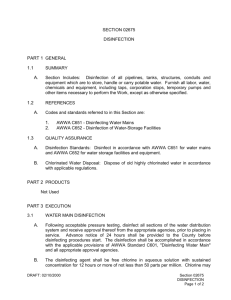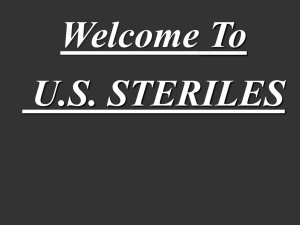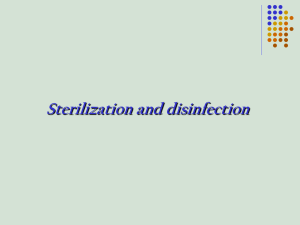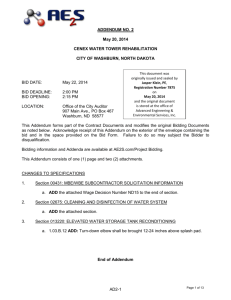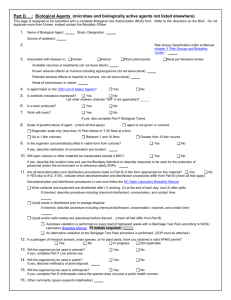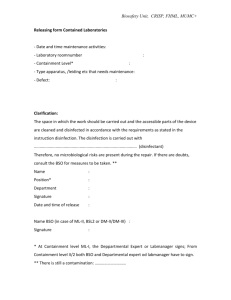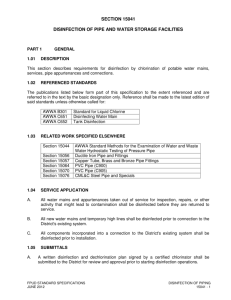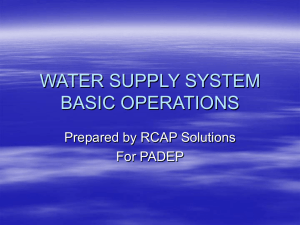11201-System Disinfection
advertisement
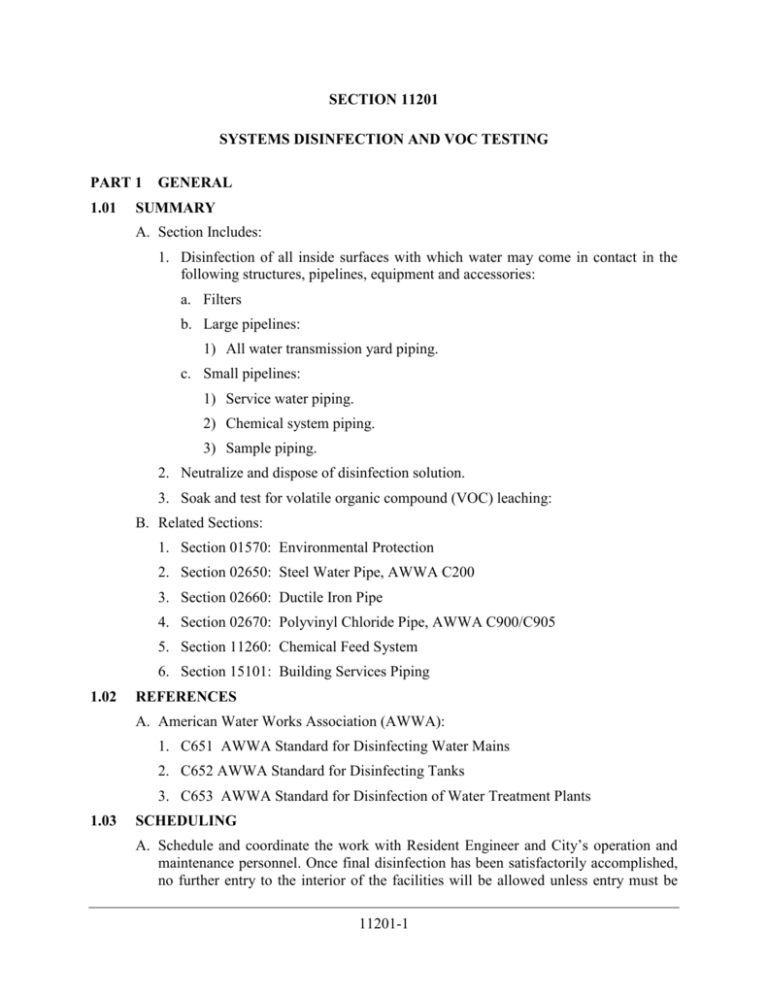
SECTION 11201 SYSTEMS DISINFECTION AND VOC TESTING PART 1 1.01 GENERAL SUMMARY A. Section Includes: 1. Disinfection of all inside surfaces with which water may come in contact in the following structures, pipelines, equipment and accessories: a. Filters b. Large pipelines: 1) All water transmission yard piping. c. Small pipelines: 1) Service water piping. 2) Chemical system piping. 3) Sample piping. 2. Neutralize and dispose of disinfection solution. 3. Soak and test for volatile organic compound (VOC) leaching: B. Related Sections: 1. Section 01570: Environmental Protection 2. Section 02650: Steel Water Pipe, AWWA C200 3. Section 02660: Ductile Iron Pipe 4. Section 02670: Polyvinyl Chloride Pipe, AWWA C900/C905 5. Section 11260: Chemical Feed System 6. Section 15101: Building Services Piping 1.02 REFERENCES A. American Water Works Association (AWWA): 1. C651 AWWA Standard for Disinfecting Water Mains 2. C652 AWWA Standard for Disinfecting Tanks 3. C653 AWWA Standard for Disinfection of Water Treatment Plants 1.03 SCHEDULING A. Schedule and coordinate the work with Resident Engineer and City’s operation and maintenance personnel. Once final disinfection has been satisfactorily accomplished, no further entry to the interior of the facilities will be allowed unless entry must be 11201-1 made to perform repairs, in which case repeat disinfection on a localized basis at no additional cost to the City. The Contractor shall be responsible for maintaining security of the disinfected facilities. B. Disinfect pipelines following successful pressure testing. C. Conduct test for VOC, after successfully completing disinfection and prior to putting tank in service. 1.04 SUBMITTALS A. Submit in accordance with Section 01300. B. Submit a Disinfection Plan and VOC Testing Plan and Report in the Product Information category including the procedures, methods, materials and schedules proposed for disinfecting the required surfaces, method of dechlorinating and disposing of chlorinated water, and sampling, testing and reporting for VOC and disinfection residual. 1.05 QUALITY ASSURANCE A. Laboratory testing related to disinfection and VOC testing will be performed by and paid for by the City. PART 2 2.01 PRODUCTS MATERIALS A. Water: Use potable water. PART 3 3.01 EXECUTION PREPARATION A. Provide all necessary appurtenances required for the disinfection procedures including taps, temporary piping, connections and shutoff valves. Submit data on appurtenances which will be permanently installed for review by the Resident Engineer. B. The Contractor is advised that precautions taken to keep surfaces clean during construction and avoiding the entry of deleterious substances on the work during construction will facilitate achieving the disinfection requirements of this project. C. Prior to disinfecting, thoroughly clean accessible surfaces of dust, dirt, foreign matter and deleterious substances. Remove any oil by contact with absorbents. Use water sprays, steam cleaning, vacuum cleaning, swabbing, hand brushing or a combination of methods and rinsing to effect the cleaning, but do not use any method that will be detrimental to the finish surfaces. Flush inaccessible surfaces clean. D. Hydraulic flushing shall be greater than 2.5 feet per second (fps) with 5 fps as goal. 3.02 APPLICATION A. After completing all construction activities, including painting and application of elastomeric membranes, and after allowing a minimum of ten (10) days for the paint and/or elastomeric membranes to cure, disinfect the required surfaces with chlorine solutions in accordance with the following procedures. Following disinfection and 11201-2 flushing, the City will take water samples for bacteriological analysis of the water. If the specified bacteriological requirements are not satisfied, repeat disinfection procedure until the requirements are met. B. Large Pipelines: 1. Standard: AWWA C651 as amended herein. 2. Forms of Chlorine: Sodium hypochlorite 3. Method: Continuous feed. C. Small Pipelines: 1. Preparation: Provide the system with a 1-inch minimum service cock or valve or other means to inject chlorine solution at a point within 2 or 3 feet of its junction with the supply source. When system is complete, thoroughly flush it by fully opening every outlet until clear water flows from all of them. 2. Disinfecting Agent: Sodium hypochlorite or calcium hypochlorite in sufficient quantities to produce chlorine concentration of at least 50 ppm in the system. 3. Disinfecting Procedure: a. Connect a hand-operated pump, or other means of injecting the disinfecting agent, to one-inch minimum service cock or valve or other injection device. Pump must provide a pressure greater than that of supply of system. b. With system completely full of water and supply valve open, proceed to adjust every outlet of system so that a trickle of water flows from each. c. Inject disinfectant slowly and continuously at an even rate, not in slugs, until a test at each outlet shows a free chlorine residual concentration of at least 25 parts per million. d. Close all outlets and valves, including valve connecting to supply line and one-inch minimum service cock on solution injection connection. Maintain condition for 24 hours. After 24 hours, test for residual chlorine at each outlet. The free residual chlorine concentration indicated should be not less than 10 ppm. If the indicated free chlorine concentration is less than 10 ppm, repeat disinfection procedure until an approved result is obtained. e. When the above procedure has been completed to the satisfaction of the Resident Engineer, flush out entire system with fresh water until tests at all outlets show a residual of not more than 0.4 ppm. D. After successful completion of bacteriological analysis of water (two tests required, 24 hours apart), test each tank and vessel for volatile organic compounds. 3.03 FIELD QUALITY CONTROL A. Chlorine Residual Testing: AWWA C651, Appendix A, DPD Drop Dilution Method, except where otherwise specified. Testing shall be performed by Contractor. B. Bacteriological Analyses of Water: After the completion of disinfecting procedure, including the final flushing as described in AWWA C651 and herein, the Resident 11201-3 Engineer will obtain water samples from this system for bacteriological analyses. Requirements for satisfactory disinfection of water supply are that bacteriological analyses indicate that water samples are negative for coliform organisms, and that Heterotrophic plate count (standard plate count) is less than 100 colony forming units per milliliter. If bacteriological analyses do not satisfy the above requirements, then repeat disinfection procedure until these requirements are met. C. Testing for Volatile Organic Compounds: 1. After pipes have been disinfected, fill to maximum design levels, then allow to soak for at least five days before samples of the water from pipe are collected and analyzed for volatile organic compounds. The samples are to be analyzed at the City’s expense by a laboratory certified by the State Department of Health Services (DHS) to conduct volatile organic analyses. The constituents that will be analyzed for by a volatile organics scan are listed on the reporting form required by the DHS. Reporting forms may be obtained from DHS. Analysis shall conform to EPA Method 524.2. 2. If any test fails, repeat the test procedure in five days time from the initial test at no additional cost to the City. If the repeat test also fails, dispose of the contaminated water in accordance with Section 01570. Refill the pipe with water and retest as described above. The cost of the retest and the water to fill the tank or vessel shall be at the Contractor’s expense. If any test fails a second time, the final acceptance of the pipe shall be subject to a negotiation between the Contractor and the City. 3.04 DISPOSAL OF DISINFECTION SOLUTION A. Dechlorinate and dispose of water in accordance with applicable regulations and Section 01570. Contractor shall be required to obtain all required permits and submit a Storm Water Pollution Prevention Plan (SWPPP) per Section 01570 and these Specifications at no cost to the City. 3.05 PROTECTION OF DISINFECTED STRUCTURES A. If required to re-enter a disinfected structure, the work shall be conducted utilizing techniques and work methods as necessary to maintain the disinfected status. This shall include use of disinfected foot coverings, tools, and the like. In the event the Contractor contaminates the facilities, effect decontamination at no additional cost to the City. **END OF SECTION** 11201-4
